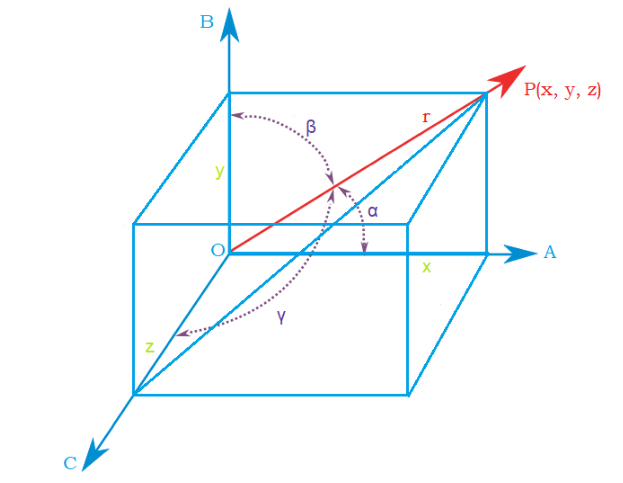Question
Question: If \(l,m,n\) are direction cosines of a straight line then prove that \({l^2} + {m^2} + {n^2} = 1\)....
If l,m,n are direction cosines of a straight line then prove that l2+m2+n2=1.
Solution
Find the dimensions of the lines joining the x,y and z axes, to use it further into the equation formed by solving the equations of direction cosines using the distance formula. We use simple coordinates to represent the values of the given angles and the points.
Complete step-by-step solution:

Let O be the origin and OP be a line Which has the direction cosines as l,m,n.
Let the coordinates of P be (x,y,z).
Let the length of the line OP be r.
The coordinates of origin O=(0,0,0).
Using the three- coordinates distance formula:
OP=(x−0)2+(y−0)2+(z−0)2
⇒OP=x2+y2+z2
Squaring on both sides of the equation, we get:
OP2=x2+y2+z2
Now, OP=r
Substituting OP=r in the above equation
r2=x2+y2+z2−−−−(1)
PA,PB,PC are joined perpendicularly on the coordinate axes such that:
OA=x, OB=y, OC=z
The angles between the following lines with the origin are as follows:
∠POA=α, ∠POB=β, ∠POC=γ
Now,
Given direction cosines are l,m,n.
cosα=l, cosβ=m, cosγ=n
Let us consider the △AOP,
cosα=rx
By using cosα=l we get,
⇒l=rx
Hence,
⇒x=lr
Squaring on both sides:
x2=l2r2−−−−(2)
Similarly,
cosβ=ry
By using cosβ=m we get,
⇒m=ry
Hence,
⇒y=mr
Squaring on both sides:
y2=m2r2−−−−(3)
And,
cosγ=rz
By using cosγ=n we get,
⇒n=rz
Hence,
⇒z=nr
Squaring on both sides:
z2=n2r2−−−−(4)
∴ x=lr, y=mr, z=nr
Adding 2, 3, 4, we get:
x2+y2+z2=l2r2+m2r2+n2r2
Taking out the common terms
⇒x2+y2+z2=(l2+m2+n2)r2
From equation 1:
⇒r2=(l2+m2+n2)r2
Cancelling the common terms on both the sides, that is diving both the sides using r2
l2+m2+n2=1
Hence proved
Note: In analytic geometry, the direction cosines (or directional cosines) of a vector are the cosines of the angles between the vector and the three coordinate axes. Equivalently, they are the contributions of each component of the basis to a unit vector in that direction. Direction cosines are an analogous extension of the usual notion of slope to higher dimensions.
